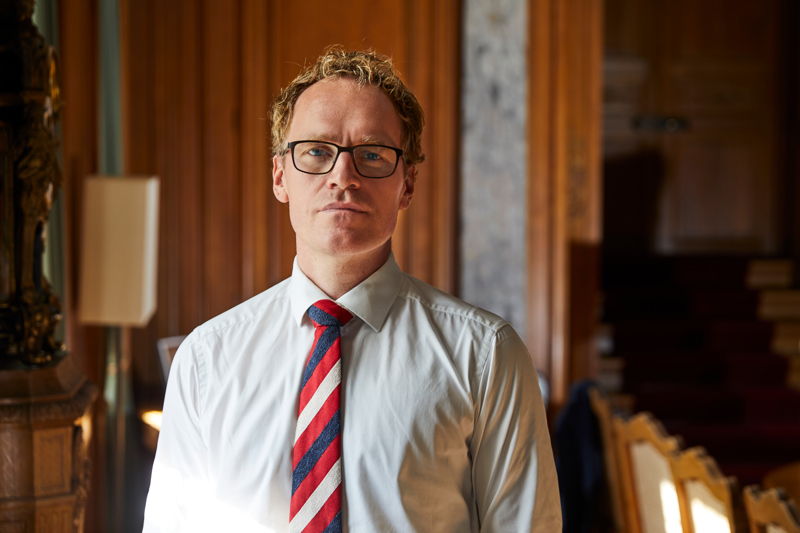Chief Analyst: Long-term prospects for low inflation
Jens Nærvig, Chief Analyst at Danske Bank, has investigated 100 years of inflation and has an idea of when inflation will fall again.
In his own words, Jens Nærvig could very well “sit at a university and research monetary policy”.
He doesn’t do that.
Instead, the 37-year-old economist has been on the payroll of Danske Bank since 2008, first with the title of student assistant and now as chief analyst, but with the history and research he likes.

According to Jens Nærvig, one of the challenges with today’s towering inflation is that there are not many left in the financial sector who have hands-on experience with it. Photo: Casper Jarlberg
He wrote his thesis on monetary policy and the communication with central banks, and in a time of galloping inflation, what could be more obvious than looking at the historical examples of similar episodes?
Together with his boss Heidi Schaumann, he mapped all cases over the past 100 years in the U.S., England, Germany, Sweden, Norway and Denmark, where inflation first rose to over 7 per cent and later fell to less than 3 percent again.
The reason was that he wanted to better understand the extraordinary situation the world economy was in and “be a little more humble” in their analysis, he explains.
The results of the investigation showed that this has happened as many as 35 times before, but not since the 1970s.
“I spend most of my time making forecasts, but we haven’t experienced this here before. For 40 years, the central banks have had an objective of 2 per cent inflation, so perhaps it has been too much of an assumption to believe that they just know what needs to be done when they’ve spent the last 10 years dealing with too low inflation”, says Jens Nærvig with regard to the fact that the central banks are suddenly facing a new challenge.
Wars and crises cause high inflation
Inflation is when a wide range of goods increase in price. The fact that petrol quickly increased to almost DKK 20 per litre and then decreased to 14 again is not inflation, it is supply and demand in the oil market. But when butter, milk, cereals, grains and pretty much everything you can buy in a supermarket increases dramatically at the same time, that’s inflation.
Historically, wars and crises have been catalysts for inflation, explains Jens Nærvig. After WWI and WWII, The Vietnam War in the 1960s was instrumental and the oil crisis at the beginning of the 1970s ignited it further.

Jens Nærvig believes that the financial sector should have been able to foresee that something would happen based on developments after the corona crisis.
Long-term prospects for low inflation
According to Jens Nærvig, one of the challenges with today’s towering inflation is that there are not many left in the financial sector who have hands-on experience with it. Inflation is something you read about in dusty books.
The last time it was a big problem was before Jens Nærvig was born. The fixed exchange rate policy and the central banks’ focus on keeping it at 2 per cent really took hold in the 1980s and since then inflation has not been a factor that the financial sector has had to deal with in isolation.
So there may be an experience where inflation is a completely new problem that you have to deal with and learn to understand. But when you’ve just looked at 100 years of inflation and found 35 crises – and never experienced one yourself – what have you really learned?
“We found that it takes between two and five years for inflation above seven per cent to drop below three per cent. The median for the 35 crises is two and a half years. Macroeconomically, the conditions of a war, corona and a depressed economy that is stuck might be reminiscent of the problems in the 1960s and 1970s”, he says.
There are examples of economies that have come out of inflationary crises quickly, but the common feature of those was that it was a country with a failed economic policy which was rectified quickly.
“There wasn’t a stressed world economy with a war and pandemic in the same way. If we look at the historical record, it will probably take a long time to get down to two per cent again”, Jens Nærvig says about the unfortunately grim lesson of 100 years of inflation history.
Crisis management in a few weeks
After several decades of low inflation, there were several coincidences that meant that many countries – including Denmark – are now close to 10 per cent inflation.
- Born 1985 in Ishøj
- Master of Science in Economics, 2011
- Lives in Frederiksberg with his girlfriend Nete and their three children ages 1, 6 and 10.
- Started at Danske Bank as a student assistant in 2008 and is now a chief analyst.
The first factor for the problems in Denmark was that the enormous aid packages were made in the first weeks of the corona crisis. The lesson from the financial crisis at the end of the 2000s was that it is better to help a lot and quickly rather than to wait and see.
At that time, around 170,000 jobs disappeared in a few years, people's private finances were affected for a long time, and this affected the Danish economy. That development had to be avoided at almost any cost.
“In the clear light of hindsight, the corona policy was too lenient. It was described as the worst crisis since WWII, but the economic crisis was over faster than the pandemic: In the course of a few weeks, they pursued the same policy that they spent five years on after the financial crisis. It matters whether you spread aid packages over five years or a few weeks”, says Jens Nærvig.
Lack of alarm bells
The aid during corona, where people got money but could not spend it in the closed shops, meant that demand exploded when the world opened up again.
“The crisis did not make us more productive, but we had more money. So the prices had to go up. There was a lot of money in people’s pockets in many countries, but the companies couldn’t keep up with the demand, and so the prices went up”, he adds.
The spiral of rising inflation was thus already secretly well under way when Russia invaded Ukraine in late February. The invasion caused the prices of various key commodities to skyrocket and that accelerated the whole thing.
Jens Nærvig believes that the financial sector should have been able to foresee that something would happen based on developments after the corona crisis.
“The alarm bells should have started sounding before the invasion. What caused the warnings to not be taken seriously enough was that the central banks said that inflation would rise a little and after many years of very low inflation, we expected it to rise a little”, he says.
Blind spot
The focus was on the supply side, so inflation should probably fall again once supply increased, was the rationale. The problem was simply that there was not enough attention to the fact that people had too much money, while at the same time there were too few goods on the shelves. In that way, it was a bit of a repeat of the 1970s, and we haven’t had to be aware of it since.
“We had a blind spot there”, explains Jens Nærvig, returning to the start of the analysis, its results and his desire to sit at a university and do research:
“It may not quite be research, but it’s a contribution to understanding what has happened in the past when inflation has risen so dramatically”, says Jens Nærvig on the review of 100 years of inflation history and 35 crises.





